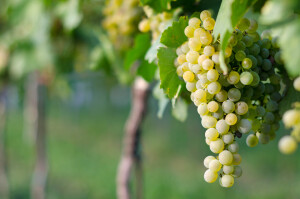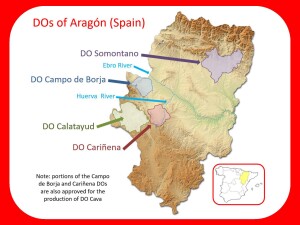 The Cariñena Denominación de Origen (DO Cariñena) is a well-established wine region located along the Heurva River in Aragón (an autonomous community in northeastern Spain). Originally established in 1932, the DO Cariñena produces a range of wine styles—including tinto, blanco, and rosado in versions from dry-to-sweet; plus sparkling wine, semi-sparkling wine (vino de aguja), and fortified wine (vino de licor).
The Cariñena Denominación de Origen (DO Cariñena) is a well-established wine region located along the Heurva River in Aragón (an autonomous community in northeastern Spain). Originally established in 1932, the DO Cariñena produces a range of wine styles—including tinto, blanco, and rosado in versions from dry-to-sweet; plus sparkling wine, semi-sparkling wine (vino de aguja), and fortified wine (vino de licor).
All of these wines are allowed to be produced using a long list of grapes, sorted into those considered “principal“ and those considered “secondary.” In order to use the label term “Superior,” the wine must contain a minimum of 85% principal grape varieties (variedades de uva principales). It comes as no surprise that Cariñena is listed among the appellation’s principal grape varieties.
Cariñena—a vigorous, high-tannin red variety—is a grape of many names; in France, it is known as Carignan; in Catalonia, it is known as Samsó; and much of the world knows it as Mazuelo. It is believed that Mazuelo was the original name, derived from the town of Mazuelo de Muñó (located in Burgos [Castilla y León]). It is further believed that the locally preferred name Cariñena derives from the town of the same name (one of the 16 towns of the Zaragoza Province included within the confines of the DO).
 The white mutation of the grape—redolent with citrus aromas and often used in white blends—is known across Spain as Cariñena Blanca, Mazuelo Blanco, or Samsó Blanco. As it stands to reason, in France it goes by Carignan Blanc. Loyal readers of this blog might recall that Cariñena Blanca was only quite recently added to the official list of approved varieties in Spain, and that the Empordà DO was the first appellation to allow its use in the PDO wines of the region. (At the time, I received many comments relating that it seemed odd that it was not year approved in the Cariñena DO—agreed!)
The white mutation of the grape—redolent with citrus aromas and often used in white blends—is known across Spain as Cariñena Blanca, Mazuelo Blanco, or Samsó Blanco. As it stands to reason, in France it goes by Carignan Blanc. Loyal readers of this blog might recall that Cariñena Blanca was only quite recently added to the official list of approved varieties in Spain, and that the Empordà DO was the first appellation to allow its use in the PDO wines of the region. (At the time, I received many comments relating that it seemed odd that it was not year approved in the Cariñena DO—agreed!)
However, it seems that the Cariñena DO has come around and—as of February of 2023—Cariñena Blanca has been approved for use (as a secondary variety) in the white wines and sparkling wines of the appellation (fortified wines must be produced solely from principal varieties).
It is believed that viticulture in Aragón began in the area near the town of Cariñena. The area was formerly a Roman town known as Carae, whose inhabitants of Carae were known to have enjoyed a locally produced wine mixed with home as far back as the third century BCE. Documentation concerning planting restrictions on vineyards dates back to 1696.
 The Cariñena DO contains a diverse range of soil types and is characterized by low rainfall, extreme temperatures, and a strong, dry, northerly wind known as the cierzo.
The Cariñena DO contains a diverse range of soil types and is characterized by low rainfall, extreme temperatures, and a strong, dry, northerly wind known as the cierzo.
Note: The complete list of principal grape varieties of the DO Cariñena includes the following grapes in addition to Cariñena: Cabernet Sauvignon, Garnacha Tinta, Merlot, Syrah, Tempranillo, Chardonnay, Garnacha Blanca, and Macabeo. The list of secondary varieties includes the following (in addition to Cariñena Blanca): Juan Ibáñez (Moristel), Monastrell (Mourvèdre), Vidadillo (Vidalillo de Almonacid), Muscat of Alexandria (Moscatel de Alejandría), Parellada, Sauvignon Blanc, and Verdejo.
References/for more information:
- EU Journal regarding Carinena DO 2023
- Pliego de condiciones Cariñena DO updated 2023
- The Cierzo Wind— https://en.wikipedia.org/wiki/Cierzo
Post authored by Jane A. Nickles…your blog administrator: jnickles@societyofwineeducators.org